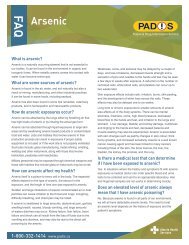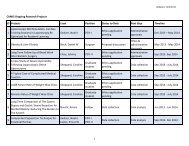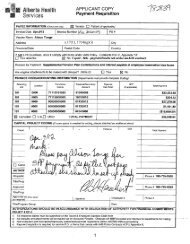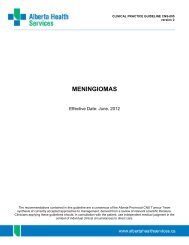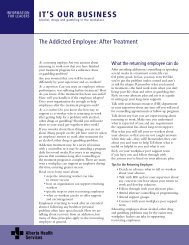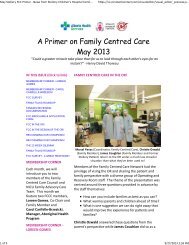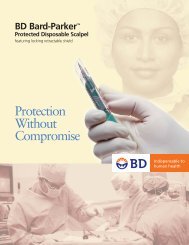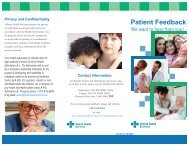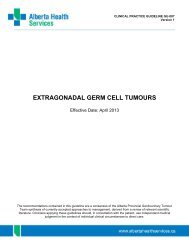management of febrile neutropenia in adult cancer patients
management of febrile neutropenia in adult cancer patients
management of febrile neutropenia in adult cancer patients
You also want an ePaper? Increase the reach of your titles
YUMPU automatically turns print PDFs into web optimized ePapers that Google loves.
CLINICAL PRACTICE GUIDELINE SUPP-002<br />
MANAGEMENT OF FEBRILE NEUTROPENIA<br />
IN ADULT CANCER PATIENTS<br />
Date Developed: November, 2008<br />
Last Revised: January, 2012<br />
The recommendations conta<strong>in</strong>ed <strong>in</strong> this guidel<strong>in</strong>e are a consensus <strong>of</strong> the Alberta Prov<strong>in</strong>cial Tumour Teams and are<br />
a synthesis <strong>of</strong> currently accepted approaches to <strong>management</strong>, derived from a review <strong>of</strong> relevant scientific literature.<br />
Cl<strong>in</strong>icians apply<strong>in</strong>g these guidel<strong>in</strong>es should, <strong>in</strong> consultation with the patient, use <strong>in</strong>dependent medical judgment <strong>in</strong><br />
the context <strong>of</strong> <strong>in</strong>dividual cl<strong>in</strong>ical circumstances to direct care.
SUMMARY OF KEY POINTS<br />
CLINICAL PRACTICE GUIDELINE SUPP-002<br />
1. Febrile <strong>neutropenia</strong> is def<strong>in</strong>ed as:<br />
• Fever higher than 38.3°C for 1 hour OR higher than 38.0°C for more than 1 hour, <strong>in</strong> a patient<br />
who has received chemotherapy <strong>in</strong> the past month, AND<br />
• Neutrophils less than 0.5 x 10 9 cells/L OR likely to fall to less than 0.5 x 10 9 cells/L<br />
2. Patients suspected <strong>of</strong> hav<strong>in</strong>g <strong>febrile</strong> <strong>neutropenia</strong> should undergo:<br />
• History and physical exam to determ<strong>in</strong>e the site <strong>of</strong> <strong>in</strong>fection<br />
• Complete hematological pr<strong>of</strong>ile and chemistry pr<strong>of</strong>ile<br />
• Chest-x-ray<br />
3. Antibiotic therapy should be tailored to the cause <strong>of</strong> the <strong>febrile</strong> <strong>neutropenia</strong>, if found. Otherwise,<br />
preferred <strong>in</strong>itial antibiotic therapy is usually either <strong>in</strong>travenous piperacill<strong>in</strong>-tazobactam 4.5 grams IV<br />
every 8 hours or ceftazidime 2 grams every 8 hours, plus <strong>in</strong>travenous fluids.<br />
4. Patients with <strong>febrile</strong> <strong>neutropenia</strong> who are felt to be at low risk <strong>of</strong> complications may be managed as<br />
an outpatient.<br />
Important Contact Information<br />
After assess<strong>in</strong>g the patient, call the responsible medical oncologist or the after hours medical<br />
oncologist on-call for a consultation:<br />
• Calgary (Tom Baker Cancer Centre): (403) 944-1110<br />
• Edmonton (Cross Cancer Institute): (780) 432-8771<br />
• Medic<strong>in</strong>e Hat Cancer Cl<strong>in</strong>ic: (403) 529-8817<br />
• Red Deer (Central Alberta Cancer Centre): (403) 343-4526<br />
• Lethbridge (Jack Ady Cancer Centre): (403) 329-0633<br />
• Grande Prairie Cancer Centre: (780) 538-7588<br />
If septic shock is a concern, physicians and health-care providers can call the RAAPID l<strong>in</strong>e:<br />
• Northern Alberta: 1-800-282-9911<br />
• Southern Alberta: 1-800-661-1700<br />
BACKGROUND<br />
Febrile <strong>neutropenia</strong> is considered an oncologic and medical emergency. Mortality rates <strong>of</strong> 5 to 20% have<br />
been reported. 1,2 More than 70% <strong>of</strong> <strong>patients</strong> present<strong>in</strong>g with <strong>febrile</strong> <strong>neutropenia</strong> have an underly<strong>in</strong>g<br />
hematological disease (e.g., leukemia, lymphoma, other), while the majority <strong>of</strong> rema<strong>in</strong><strong>in</strong>g cases <strong>of</strong>ten<br />
present with underly<strong>in</strong>g neoplasms (i.e., solid tumours) or multiple myeloma. 3 Chemotherapy has been<br />
reported as the cause <strong>of</strong> <strong>neutropenia</strong> <strong>in</strong> nearly 90% <strong>of</strong> cases. 3 Solid tumours requir<strong>in</strong>g chemotherapy that<br />
may put <strong>patients</strong> at an <strong>in</strong>creased risk <strong>of</strong> <strong>febrile</strong> <strong>neutropenia</strong> <strong>in</strong>clude breast <strong>cancer</strong>, colorectal <strong>cancer</strong>, lung<br />
<strong>cancer</strong> (small cell and non-small cell), and ovarian <strong>cancer</strong>. 4-6<br />
The use <strong>of</strong> empiric broad-spectrum antibiotics has significantly reduced the mortality and morbidity <strong>of</strong> this<br />
common chemotherapy complication. However, rapid assessment and <strong>in</strong>stitution <strong>of</strong> the appropriate<br />
1
CLINICAL PRACTICE GUIDELINE SUPP-002<br />
antibiotics are <strong>of</strong> paramount importance. A patient on chemotherapy should not wait <strong>in</strong> the emergency<br />
department for assessment for an extended period <strong>of</strong> time; ideally a system would be <strong>in</strong> place for the rapid<br />
identification <strong>of</strong> a potential patient with <strong>febrile</strong> <strong>neutropenia</strong> who would then immediately have a complete<br />
blood count (CBC) drawn and urgent assessment by a health care pr<strong>of</strong>essional.<br />
The objective <strong>of</strong> this guidel<strong>in</strong>e is to provide cl<strong>in</strong>icians (i.e., emergency room physicians and nurses) and<br />
family physicians with strategies for the <strong>management</strong> <strong>of</strong> <strong>adult</strong> <strong>patients</strong> with solid tumours or hematologic<br />
malignancies who present with <strong>febrile</strong> <strong>neutropenia</strong>.<br />
GUIDELINE QUESTIONS<br />
1. What is the def<strong>in</strong>ition <strong>of</strong> <strong>febrile</strong> <strong>neutropenia</strong> for <strong>adult</strong> <strong>patients</strong> with solid tumours or hematologic<br />
malignancies?<br />
2. What pre-treatment <strong>in</strong>vestigations should be conducted for <strong>adult</strong> out<strong>patients</strong> suspected <strong>of</strong> hav<strong>in</strong>g<br />
<strong>febrile</strong> <strong>neutropenia</strong>?<br />
3. What antibiotic therapy regimens are recommended for the treatment <strong>of</strong> <strong>febrile</strong> <strong>neutropenia</strong> <strong>in</strong> <strong>adult</strong><br />
<strong>patients</strong> with solid tumours or hematologic malignancies?<br />
4. What are the recommended <strong>management</strong> strategies for <strong>adult</strong> <strong>patients</strong> with low-risk <strong>febrile</strong><br />
<strong>neutropenia</strong>?<br />
DEVELOPMENT<br />
The orig<strong>in</strong>al version <strong>of</strong> this guidel<strong>in</strong>e was created and reviewed by the Alberta Medical Affairs and<br />
Community Oncology (MACO) Medical Liaison Team. For the 2011 update, evidence was selected,<br />
reviewed, and endorsed by a work<strong>in</strong>g group comprised <strong>of</strong> oncologists specializ<strong>in</strong>g <strong>in</strong> breast, ovarian,<br />
colorectal, and lung <strong>cancer</strong>s, hematologists, and family physicians, as well as two Knowledge<br />
Management Specialists from the Guidel<strong>in</strong>e Utilization Resource Unit]. A detailed description <strong>of</strong> the<br />
methodology followed dur<strong>in</strong>g the guidel<strong>in</strong>e development process can be found <strong>in</strong> the Guidel<strong>in</strong>e Utilization<br />
Resource Unit Handbook.<br />
In order to achieve consensus on the key po<strong>in</strong>ts, a survey was created, based on the AGREE II<br />
<strong>in</strong>strument, 7 and adm<strong>in</strong>istered onl<strong>in</strong>e to specialists <strong>in</strong> oncology, hematology, and <strong>in</strong>fectious diseases, as<br />
well as family physicians. The survey conta<strong>in</strong>ed items that asked reviewers to rate their level agreement<br />
with each <strong>of</strong> the key po<strong>in</strong>ts, as well as their level <strong>of</strong> agreement that the key po<strong>in</strong>ts were evidence-based.<br />
Other survey items <strong>in</strong>cluded level <strong>of</strong> agreement that the guidel<strong>in</strong>e questions, search strategy, and target<br />
audience were each clearly described, overall agreement with the guidel<strong>in</strong>e, and will<strong>in</strong>gness to<br />
recommend use <strong>of</strong> the guidel<strong>in</strong>e. For all items, a 7-po<strong>in</strong>t scale, rang<strong>in</strong>g from strongly agree (7) to strongly<br />
disagree (1), was used. Respondents were also permitted to provide open-ended comments on each item.<br />
A total <strong>of</strong> eight reviewers responded with feedback. There were five medical oncologists, one family<br />
physician, one <strong>in</strong>fectious diseases specialist, and one general <strong>in</strong>ternist work<strong>in</strong>g ma<strong>in</strong>ly <strong>in</strong> oncology,<br />
represent<strong>in</strong>g Calgary, Edmonton, Red Deer, Grande Prairie, and Medic<strong>in</strong>e Hat. Survey items that<br />
achieved a score <strong>of</strong> 6 to 7 from at least 80% <strong>of</strong> the reviewers were deemed acceptable without further<br />
edits; all other survey items were deemed important areas for consideration and/or revision. Overall,<br />
2
CLINICAL PRACTICE GUIDELINE SUPP-002<br />
revisions were considered for the follow<strong>in</strong>g eight items: target population, key po<strong>in</strong>ts #2, #3, and #4,<br />
contact <strong>in</strong>formation, balance <strong>of</strong> benefits and risks, l<strong>in</strong>kage <strong>of</strong> the recommendations to the evidence base,<br />
and appearance <strong>of</strong> the key recommendations. The guidel<strong>in</strong>e was then edited to better reflect the majority<br />
op<strong>in</strong>ion.<br />
SEARCH STRATEGY<br />
For this guidel<strong>in</strong>e update, medical journal articles were searched us<strong>in</strong>g Medl<strong>in</strong>e (1985 to June Week 1,<br />
2011), EMBASE (1985 to June Week 1, 2011), Cochrane Database <strong>of</strong> Systematic Reviews (1985 to 2 nd<br />
Quarter, 2011), and PubMed electronic databases; the references and bibliographies <strong>of</strong> articles identified<br />
through these searches were scanned for additional sources.<br />
The search terms <strong>in</strong>cluded: Neutropenia [MeSH term] AND Fever [MeSH term], AND Neoplasms [MeSH<br />
term] OR Lymphoma [MeSH term], AND Drug Therapy [MeSH term] OR Drug Therapy Comb<strong>in</strong>ation<br />
[MeSH term], AND cl<strong>in</strong>ical trial OR controlled cl<strong>in</strong>ical trial OR meta analysis OR multicenter study OR<br />
practice guidel<strong>in</strong>e OR randomized controlled trial.<br />
Articles were excluded from the f<strong>in</strong>al review if they: had a non-English abstract, were a case study<br />
<strong>in</strong>volv<strong>in</strong>g less than 30 <strong>patients</strong>, <strong>in</strong>volved pediatric <strong>patients</strong>, or were published prior to January 1985. A<br />
systematic search for new or updated practice guidel<strong>in</strong>es published s<strong>in</strong>ce January 2000 was also<br />
conducted. Guidel<strong>in</strong>es from the National Comprehensive Cancer Network (NCCN), British Columbia<br />
Cancer Agency (BCCA), and Infectious Diseases Society <strong>of</strong> America (IDSA) were deemed to be most<br />
relevant and corresponded best with local context and practice.<br />
TARGET POPULATION<br />
The follow<strong>in</strong>g guidel<strong>in</strong>es apply to <strong>adult</strong> out<strong>patients</strong> who have been treated with chemotherapy for solid<br />
tumours or hematologic malignancies with<strong>in</strong> the past month and who present with <strong>febrile</strong> <strong>neutropenia</strong>.<br />
Different pr<strong>in</strong>ciples may apply to <strong>in</strong><strong>patients</strong> and to pediatric <strong>patients</strong>.<br />
RECOMMENDATIONS AND DISCUSSION<br />
The follow<strong>in</strong>g are guidel<strong>in</strong>es for the <strong>management</strong> <strong>of</strong> <strong>adult</strong> <strong>cancer</strong> <strong>patients</strong> with <strong>febrile</strong> <strong>neutropenia</strong>. Every<br />
patient has a unique presentation and should be managed as such. Daily reassessments are required to<br />
ensure that the patient is recover<strong>in</strong>g satisfactorily.<br />
Who to Contact<br />
The on-call medical oncologist or responsible medical oncologist (if available) should be contacted when<br />
any patient presents with <strong>febrile</strong> <strong>neutropenia</strong>. The responsible medical oncologist should be contacted for<br />
any additional concerns relat<strong>in</strong>g to the care <strong>of</strong> a patient with <strong>febrile</strong> <strong>neutropenia</strong>. Another useful resource<br />
would be the on-call <strong>in</strong>fectious diseases specialist at the University <strong>of</strong> Alberta Hospital (Edmonton) or at<br />
the Foothills Hospital (Calgary).<br />
3
Guidel<strong>in</strong>e Question 1. How is <strong>febrile</strong> <strong>neutropenia</strong> def<strong>in</strong>ed?<br />
CLINICAL PRACTICE GUIDELINE SUPP-002<br />
The work<strong>in</strong>g group reviewed several descriptions <strong>of</strong> <strong>febrile</strong> <strong>neutropenia</strong> from published studies; 8-20 <strong>in</strong><br />
addition, def<strong>in</strong>itions <strong>in</strong>cluded <strong>in</strong> published cl<strong>in</strong>ical practice guidel<strong>in</strong>es were reviewed and are summarized<br />
below <strong>in</strong> Table 1. 21-27<br />
Table 1. Published def<strong>in</strong>itions <strong>of</strong> <strong>febrile</strong> <strong>neutropenia</strong>.<br />
Source Fever (ºC) Neutropenia (x 10 9 cells/L)<br />
Infectious Diseases Society <strong>of</strong><br />
America, 2011 21<br />
≥38.3 oral temp. or<br />
≥38.0 over 1 hour<br />
ANC
CLINICAL PRACTICE GUIDELINE SUPP-002<br />
• Mental status<br />
• Hydration status<br />
• Oral and pharyngeal mucosa<br />
• Sk<strong>in</strong>, <strong>in</strong>clud<strong>in</strong>g any <strong>in</strong>dwell<strong>in</strong>g IV sites<br />
• Respiratory system<br />
• Abdomen<br />
• AVOID rectal exam but <strong>in</strong>clude peri-rectal <strong>in</strong>spection for abscess<br />
• Cardiovascular system <strong>in</strong>clud<strong>in</strong>g signs <strong>of</strong> sepsis<br />
• Special considerations: beware <strong>of</strong> the possibility <strong>of</strong> men<strong>in</strong>gitis, s<strong>in</strong>usitis, herpes simplex, herpes<br />
zoster, thrush (<strong>in</strong>clud<strong>in</strong>g the possibility <strong>of</strong> thrush under dentures).<br />
A complete hematological pr<strong>of</strong>ile and chemistry pr<strong>of</strong>ile should be completed. The latter is done to assess<br />
for co-morbidities or any end-organ effects <strong>of</strong> sepsis, and to determ<strong>in</strong>e if any antibiotic dose modifications<br />
or contra<strong>in</strong>dications may apply. These laboratory tests should <strong>in</strong>clude:<br />
• CBC and differential<br />
• Transam<strong>in</strong>ases, bilirub<strong>in</strong>, alkal<strong>in</strong>e phosphatase<br />
• Electrolytes<br />
• Creat<strong>in</strong><strong>in</strong>e and urea<br />
• Blood cultures<br />
o aerobic and anaerobic<br />
o peripheral and from any <strong>in</strong>dwell<strong>in</strong>g IV l<strong>in</strong>es<br />
o note: RSV is usually detected by PCR<br />
• Ur<strong>in</strong>alysis and ur<strong>in</strong>e culture (absence <strong>of</strong> pus cells on ur<strong>in</strong>alysis does not rule out UTI <strong>in</strong> the sett<strong>in</strong>g<br />
<strong>of</strong> <strong>neutropenia</strong>)<br />
• Sputum gram sta<strong>in</strong> and culture if productive<br />
• LP and CSF analysis should not be done rout<strong>in</strong>ely<br />
A chest x-ray should also be obta<strong>in</strong>ed, even <strong>in</strong> the absence <strong>of</strong> pulmonary symptoms or signs. Pulmonary<br />
<strong>in</strong>filtrates may not develop until the <strong>neutropenia</strong> beg<strong>in</strong>s to recover. Thoracic CT has not been shown to<br />
improve outcomes <strong>in</strong> the absence <strong>of</strong> cl<strong>in</strong>ical pulmonary abnormalities but can be considered <strong>in</strong> the sett<strong>in</strong>g<br />
<strong>of</strong> cl<strong>in</strong>ical abnormalities and a normal chest x-ray. Other imag<strong>in</strong>g tests should be guided by the cl<strong>in</strong>ical<br />
picture.<br />
Supplementary historical <strong>in</strong>formation (e.g., major comorbid illness, time s<strong>in</strong>ce last chemotherapy<br />
adm<strong>in</strong>istration, history <strong>of</strong> prior documented <strong>in</strong>fections, recent antibiotic therapy/prophylaxis, medications,<br />
HIV status, and recent exposures) as well as site-specific cultures (e.g., diarrhea, sk<strong>in</strong> lesions) and viral<br />
cultures (e.g., vesicular/ulcerated sk<strong>in</strong> lesions, respiratory virus symptoms) should also be obta<strong>in</strong>ed, as<br />
necessary. 21-34<br />
Guidel<strong>in</strong>e Question 3. What empiric antibiotic therapy should be given?<br />
Seed<strong>in</strong>g <strong>of</strong> the bloodstream by endogenous bacteria from the gastro<strong>in</strong>test<strong>in</strong>al tract is felt to be responsible<br />
for the majority <strong>of</strong> cases <strong>of</strong> <strong>febrile</strong> <strong>neutropenia</strong>. Many chemotherapy drugs can have adverse effects on<br />
the mucosal barrier (i.e. mucositis). Blood cultures are positive <strong>in</strong> about 30 percent <strong>of</strong> cases, and grampositive<br />
organisms are isolated more commonly than gram-negative organisms; the latter, however, are<br />
associated with more severe <strong>in</strong>fections, <strong>in</strong>clud<strong>in</strong>g sepsis. 21,28<br />
5
CLINICAL PRACTICE GUIDELINE SUPP-002<br />
Febrile <strong>neutropenia</strong> is considered an oncologic and medical emergency with high mortality if untreated,<br />
and empiric broad-spectrum antibiotics must be adm<strong>in</strong>istered immediately. 21,22,28,30 Patients transferred<br />
from the emergency department to a ward should already be receiv<strong>in</strong>g their antibiotics. Allergies, prior<br />
antibiotic history, cl<strong>in</strong>ical picture and local flora should be considered as guides. 21,22,30<br />
The <strong>in</strong>itial antibiotic therapy should be one <strong>of</strong> the follow<strong>in</strong>g broad spectrum regimens: 21-34,30-32<br />
1. Comb<strong>in</strong>ation therapy:<br />
• Piperacill<strong>in</strong>-tazobactam 4.5 grams IV every 8 hours is the treatment <strong>of</strong> choice<br />
• Tobramyc<strong>in</strong> 7 mg/kg IV every 24 hours<br />
• Comb<strong>in</strong>ation therapy is not clearly superior to monotherapy <strong>in</strong> most circumstances. Ensure that<br />
appropriate dos<strong>in</strong>g guidel<strong>in</strong>es are followed, especially <strong>in</strong> the sett<strong>in</strong>g <strong>of</strong> renal dysfunction.<br />
2. Monotherapy:<br />
• Ceftazidime 2 grams IV every 8 hours (standard regimen <strong>in</strong> AHS Cancer Care), or<br />
• Cefipime 2 grams IV every 8 hours, or<br />
• Imipenem 500 mg IV every 6 hours, or<br />
• Meropenem 500 mg IV every 6 hours<br />
3. Empiric vancomyc<strong>in</strong>:<br />
• Empiric vancomyc<strong>in</strong> should not be used rout<strong>in</strong>ely, but should be considered <strong>in</strong> the follow<strong>in</strong>g<br />
circumstances:<br />
o Concern <strong>of</strong> a major β-lactam allergy<br />
o Obvious IV catheter/tunnel <strong>in</strong>fection<br />
o Gram sta<strong>in</strong> <strong>of</strong> culture reveals gram-positive organism, with organism not yet identified<br />
o Known colonization with MRSA or penicill<strong>in</strong>-resistant S. pneumoniae<br />
o Hypotension/shock<br />
o Qu<strong>in</strong>olone antibiotic prophylaxis<br />
• In such circumstances, vancomyc<strong>in</strong> 15 mg per kg IV every 12 hours should be adm<strong>in</strong>istered, <strong>in</strong><br />
comb<strong>in</strong>ation with one <strong>of</strong>:<br />
o Gentamic<strong>in</strong> 5-7 mg/kg IV every 24 hours<br />
o Tobramyc<strong>in</strong> 7 mg/kg IV every 24 hours<br />
o Cipr<strong>of</strong>loxac<strong>in</strong> 400 mg IV every 8 to 14 hours<br />
• Vancomyc<strong>in</strong> therapy should be stopped between days three and five if the culture reveals<br />
pathogens that don’t require vancomyc<strong>in</strong> anymore.<br />
Antibiotic therapy may require modification, accord<strong>in</strong>g to cl<strong>in</strong>ical and microbiological <strong>in</strong>dicators. Reasons<br />
for modifications may <strong>in</strong>clude: the source/organism <strong>of</strong> the <strong>in</strong>fection is identified, the <strong>in</strong>fection is found not to<br />
be caused by a gram-positive organism, the patient cont<strong>in</strong>ues to be unstable after <strong>in</strong>itial therapy, or the<br />
patient becomes stable.<br />
For a more complete summary <strong>of</strong> the studies <strong>in</strong>vestigat<strong>in</strong>g these antibiotic regimens, please refer to<br />
Appendix B.<br />
6
How long should antibiotic therapy be given?<br />
CLINICAL PRACTICE GUIDELINE SUPP-002<br />
The duration <strong>of</strong> antibiotic coverage depends on the early cl<strong>in</strong>ical course and the results <strong>of</strong> any cultures -<br />
especially blood cultures. If a def<strong>in</strong>ite source <strong>of</strong> <strong>in</strong>fection is identified, such as a UTI or pneumonia, the<br />
treatment duration should be appropriate for those <strong>in</strong>fections. If a pathogen is identified <strong>in</strong> the blood<br />
cultures, especially gram negative bacilli, generally a 10 to 14 day course <strong>of</strong> antibiotics is recommended. If<br />
no source is identified either cl<strong>in</strong>ically or on blood cultures, antibiotics can be stopped if the patient is<br />
a<strong>febrile</strong> and the ANC has recovered to 0.5x10 9 cells/L, although some recommend a m<strong>in</strong>imum <strong>of</strong> seven<br />
days <strong>of</strong> therapy. If the fever resolves but the ANC is still low, there is no consensus on duration <strong>of</strong><br />
antibiotics but a reasonable strategy would be to cont<strong>in</strong>ue the antibiotics for five to ten days, depend<strong>in</strong>g on<br />
the cl<strong>in</strong>ical picture. If the still neutropenic patient is unstable or has significant mucositis, antibiotics should<br />
be cont<strong>in</strong>ued for at least 14 days even if the patient is a<strong>febrile</strong>.<br />
The 2006 version <strong>of</strong> the Capital Health Bugs & Drugs manual provides an excellent reference for the<br />
<strong>management</strong> <strong>of</strong> <strong>febrile</strong> <strong>neutropenia</strong>. 32 A version is available onl<strong>in</strong>e at www.bugsanddrugs.ca.<br />
When can oral antibiotics be given?<br />
A recent systematic review has concluded that <strong>patients</strong> who have rapidly improved on IV antibiotics and<br />
who are a<strong>febrile</strong>, stable, and no longer neutropenic can be switched to an appropriate oral regimen for the<br />
balance <strong>of</strong> the chosen antibiotic duration. 33 If these <strong>patients</strong> are stable, have no unmanaged comorbidities<br />
and have a safe and reliable home environment, they can also be discharged. If the patient has been on a<br />
prophylactic qu<strong>in</strong>olone prior to the episode <strong>of</strong> <strong>febrile</strong> <strong>neutropenia</strong>, these should be avoided on discharge.<br />
Cipr<strong>of</strong>loxac<strong>in</strong> (750mg twice daily) plus amoxicill<strong>in</strong> – clavulanate (875mg twice daily) or lev<strong>of</strong>loxac<strong>in</strong> (500mg<br />
once daily) are reasonable step-down regimens. 21 Culture and sensitivity results can also guide therapy.<br />
These results must be reviewed prior to discharge.<br />
What should be done <strong>in</strong> the case <strong>of</strong> persist<strong>in</strong>g fever?<br />
Fever <strong>in</strong> the patient with <strong>cancer</strong> can be due to the disease itself but a persist<strong>in</strong>g fever <strong>in</strong> the neutropenic<br />
patient usually suggests an ongo<strong>in</strong>g <strong>in</strong>fection not adequately treated by the current antibiotic regimen. The<br />
cl<strong>in</strong>ical picture must be thoroughly re-evaluated. Blood or other culture results should be verified and<br />
repeat cultures obta<strong>in</strong>ed if fever persists for more than three days. Empirically, vancomyc<strong>in</strong> (1 gram IV<br />
every 12 hours) is usually added at this po<strong>in</strong>t. Fungal cultures should be obta<strong>in</strong>ed and empiric antifungal<br />
therapy is recommended if fever persists beyond five days <strong>of</strong> appropriate antibacterial therapy. A medical<br />
oncologist or <strong>in</strong>fectious disease specialist should be consulted for advice regard<strong>in</strong>g the most appropriate<br />
agent.<br />
Be aware that viral <strong>in</strong>fections can also commonly occur <strong>in</strong> the patient with <strong>febrile</strong> <strong>neutropenia</strong>. Severe oral<br />
herpes can look like severe mucositis. Viral swabs and empiric antiviral therapy should be considered.<br />
Is there a role for colony stimulat<strong>in</strong>g factors?<br />
Granulocyte colony stimulat<strong>in</strong>g factor (G-CSF) can decrease the duration <strong>of</strong> <strong>neutropenia</strong>, fever and<br />
hospitalization but these benefits are modest and mortality is unaffected. 34 G-CSF can be considered <strong>in</strong><br />
hospitalized <strong>patients</strong> with pneumonia, hypotension/sepsis, organ dysfunction or a patient on a regimen<br />
that is known to cause prolonged <strong>neutropenia</strong>. 35,36 Guidel<strong>in</strong>es for the use <strong>of</strong> prophylactic G-CSF are<br />
outside <strong>of</strong> the scope <strong>of</strong> this document.<br />
7
Are there special circumstances that require more urgent attention?<br />
CLINICAL PRACTICE GUIDELINE SUPP-002<br />
Patients with <strong>febrile</strong> <strong>neutropenia</strong> can occasionally present <strong>in</strong> septic shock or have other critical care<br />
issues. These <strong>patients</strong> should be discussed with the medical oncologist as soon as possible to determ<strong>in</strong>e<br />
if critical care is appropriate. Patients on potentially curative or salvage regimens must be managed as<br />
aggressively as possible. It may be appropriate to contact the nearest critical care specialist. It may be<br />
challeng<strong>in</strong>g to determ<strong>in</strong>e the appropriate level <strong>of</strong> care for <strong>patients</strong> on palliative regimens and therefore<br />
advice should be sought <strong>in</strong> this regard from the attend<strong>in</strong>g or on call medical oncologist.<br />
Central venous catheter and tunnel <strong>in</strong>fections as well as septic thrombosis, endocarditis and osteomyelitis<br />
are special circumstances beyond the scope <strong>of</strong> this document and specific advice from the appropriate<br />
specialist should be obta<strong>in</strong>ed. This also applies to any other situation not covered here. A medical<br />
oncologist can provide direction as well.<br />
Guidel<strong>in</strong>e Question 4. How should low risk <strong>febrile</strong> <strong>neutropenia</strong> be managed?<br />
Table 2 describes the characteristics <strong>of</strong> <strong>patients</strong> at low risk for complications and high risk for<br />
complications from <strong>febrile</strong> <strong>neutropenia</strong>.<br />
Table 2. Characteristics <strong>of</strong> <strong>patients</strong> at risk for complications from <strong>febrile</strong> <strong>neutropenia</strong>. 21,22,27<br />
Low risk (most <strong>of</strong> the factors listed below)<br />
no high risk factors<br />
High risk (any <strong>of</strong> the factors listed below)<br />
outpatient status at time <strong>of</strong> development <strong>of</strong> fever <strong>in</strong>patient status at time <strong>of</strong> development <strong>of</strong> fever<br />
no associated acute comorbid illness <strong>in</strong>dependently<br />
<strong>in</strong>dicat<strong>in</strong>g <strong>in</strong>patient treatment or close observation<br />
significant cl<strong>in</strong>ical comorbidity or medically unstable<br />
anticipated short duration <strong>of</strong> severe <strong>neutropenia</strong> (≤100 anticipated prolonged severe <strong>neutropenia</strong> (≤100 cells/mcL<br />
cells/mcL for
GLOSSARY OF ABBREVIATIONS<br />
CLINICAL PRACTICE GUIDELINE SUPP-002<br />
Acronym Description<br />
AHS Alberta Health Services<br />
ANC absolute neutrophil count<br />
BCCA British Columbia Cancer Agency<br />
CBC complete blood count<br />
CSF cerebrosp<strong>in</strong>al fluid<br />
CT computed tomography scan<br />
GCSF granulocyte colony stimulat<strong>in</strong>g factor<br />
IDSA Infectious Diseases Society <strong>of</strong> America<br />
IV <strong>in</strong>travenous<br />
LP lumbar puncture<br />
MRSA methicill<strong>in</strong>-resistant Staphylococcus aureus<br />
NCCN National Comprehensive Cancer Network<br />
PCR polymerase cha<strong>in</strong> reaction<br />
RAAPID Referral, Access, Advice, Placement, Information, and Dest<strong>in</strong>ation<br />
RSV respiratory syncytial virus<br />
UTI ur<strong>in</strong>ary tract <strong>in</strong>fection<br />
DISSEMINATION<br />
• Post the guidel<strong>in</strong>e on the Alberta Health Services website.<br />
• Circulate an electronic version <strong>of</strong> the guidel<strong>in</strong>e to members <strong>of</strong> the Alberta Prov<strong>in</strong>cial Tumour Teams.<br />
• Include a l<strong>in</strong>k to document <strong>in</strong> other relevant cl<strong>in</strong>ical practice guidel<strong>in</strong>es on the Alberta Health Services<br />
website.<br />
MAINTENANCE<br />
A formal review will be conducted annually. If critical new evidence is brought forward before that time,<br />
however, the guidel<strong>in</strong>e work<strong>in</strong>g group members will revise and update the document accord<strong>in</strong>gly.<br />
CONFLICT OF INTEREST<br />
Participation <strong>of</strong> the work<strong>in</strong>g group members <strong>in</strong> the development <strong>of</strong> this guidel<strong>in</strong>e has been voluntary and<br />
the authors have not been remunerated for their contributions. There was no direct <strong>in</strong>dustry <strong>in</strong>volvement <strong>in</strong><br />
the development or dissem<strong>in</strong>ation <strong>of</strong> this guidel<strong>in</strong>e. Alberta Health Services – Cancer Care recognizes that<br />
although <strong>in</strong>dustry support <strong>of</strong> research, education and other areas is necessary <strong>in</strong> order to advance patient<br />
care, such support may lead to potential conflicts <strong>of</strong> <strong>in</strong>terest. While some members <strong>of</strong> the work<strong>in</strong>g group<br />
are <strong>in</strong>volved <strong>in</strong> research funded by <strong>in</strong>dustry or have other such potential conflicts <strong>of</strong> <strong>in</strong>terest, the<br />
developers <strong>of</strong> this guidel<strong>in</strong>e are satisfied it was developed <strong>in</strong> an unbiased manner.<br />
9
REFERENCES<br />
CLINICAL PRACTICE GUIDELINE SUPP-002<br />
1. Paul M, Yahav D, Fraser A, et al.(2006) Empirical antibiotic monotherapy for <strong>febrile</strong> <strong>neutropenia</strong>: Systematic<br />
review and meta-analysis <strong>of</strong> randomized controlled trials. J Antimicrob Chemother 57:176–189.<br />
2. Kuderer NM, Dale DC, Crawford J, et al.(2006) Mortality, morbidity, and cost associated with <strong>febrile</strong> <strong>neutropenia</strong><br />
<strong>in</strong> <strong>adult</strong> <strong>cancer</strong> <strong>patients</strong>. Cancer 106:2258–2266.<br />
3. Zuckermann J, Moreira LB, Stoll P, et al. Compliance with a critical pathway for the <strong>management</strong> <strong>of</strong> <strong>febrile</strong><br />
<strong>neutropenia</strong> and impact on cl<strong>in</strong>ical outcomes. Ann Hematol (2008) 87:139-45.<br />
4. Abernethy AP, Barbour SY, Uronis H, et al. Quality <strong>management</strong> <strong>of</strong> potential chemotherapy-<strong>in</strong>duced neutropenic<br />
complications: evaluation <strong>of</strong> practice <strong>in</strong> an academic medical center. Support Care Cancer (2009) 17:735-44.<br />
5. Dale DC. Advances <strong>in</strong> the treatment <strong>of</strong> <strong>neutropenia</strong>. Curr Op<strong>in</strong> Support Palliat Care (2009) 3:207-12.<br />
6. Othieno-Ab<strong>in</strong>ya NA, Waweru A, Nyabola LO. Chemotherapy Induced Myelosuppression. East African Medical<br />
Journal (2007) 84(1):8-15.<br />
7. AGREE II Instrument. Appraisal <strong>of</strong> Guidel<strong>in</strong>es for Research and Evaluation II. 2009. URL: www.agreetrust.org.<br />
8. H<strong>of</strong>fman JM and Huntsman Cancer Institute. NIH Study: HCI # 22418, R21 CA128228-01; Study First Received:<br />
June 25, 2008. URL: http://cl<strong>in</strong>icaltrials.gov/ ct2/show/NCT00707213<br />
9. Maschmeyer G, Nosk<strong>in</strong> GA, Ribaud P, Sepkowitz KA. Chang<strong>in</strong>g patterns <strong>of</strong> <strong>in</strong>fections and antimicrobial<br />
susceptibilities. Oncology (Williston Park) 2000;14(8 suppl 6):9–16.<br />
10. Chamorey E, Magne N, Foa C, Otto J, Largillier R, Viot M, et al. Ceftriaxone monotherapy for the treatment <strong>of</strong><br />
<strong>febrile</strong> <strong>neutropenia</strong> <strong>in</strong> <strong>patients</strong> with solid tumors: a prospective study <strong>of</strong> 100 episodes. Med Sci Monit 2004<br />
Nov;10(11):PI119-25.<br />
11. Escalante CP, Weiser MA, Manzullo E, Benjam<strong>in</strong> R, Rivera E, Lam T, et al. Outcomes <strong>of</strong> treatment pathways <strong>in</strong><br />
outpatient treatment <strong>of</strong> low risk <strong>febrile</strong> neutropenic <strong>cancer</strong> <strong>patients</strong>. Support Care Cancer 2004 Sep;12(9):657-<br />
62.<br />
12. Peacock JE, Herr<strong>in</strong>gton DA, Wade JC, Lazarus HM, Reed MD, S<strong>in</strong>clair JW, et al. Cipr<strong>of</strong>loxac<strong>in</strong> plus piperacill<strong>in</strong><br />
compared with tobramyc<strong>in</strong> plus piperacill<strong>in</strong> as empirical therapy <strong>in</strong> <strong>febrile</strong> neutropenic <strong>patients</strong>. A randomized,<br />
double-bl<strong>in</strong>d trial. Ann Intern Med 2002 Jul;137(2):77-87.<br />
13. Bauduer F, Cous<strong>in</strong> T, Boulat O, Rigal-Huguet F, Mol<strong>in</strong>a L, Fegueux N, et al.; BGMT Collaborative Group. A<br />
randomized prospective multicentre trial <strong>of</strong> cefpirome versus piperacill<strong>in</strong>-tazobactam <strong>in</strong> <strong>febrile</strong> <strong>neutropenia</strong>. Leuk<br />
Lymphoma 2001 Jul;42(3):379-86.<br />
14. Hidalgo M, Hornedo J, Lumbreras C, Trigo JM, Colomer R, Perea S, et al. Outpatient therapy with oral <strong>of</strong>loxac<strong>in</strong><br />
for <strong>patients</strong> with low risk <strong>neutropenia</strong> and fever: a prospective, randomized cl<strong>in</strong>ical trial. Cancer 1999<br />
Jan;85(1):213-9.<br />
15. Karthaus M, Wolf HH, Kämpfe D, Egerer G, Ritter J, Peters G, et al. Ceftriaxone monotherapy <strong>in</strong> the treatment <strong>of</strong><br />
low-risk <strong>febrile</strong> <strong>neutropenia</strong>. Chemotherapy 1998 Sep-Oct;44(5):343-54.<br />
16. Behre G, L<strong>in</strong>k H, Maschmeyer G, Meyer P, Paaz U, Wilhelm M, et al. Meropenem monotherapy versus<br />
comb<strong>in</strong>ation therapy with ceftazidime and amikac<strong>in</strong> for empirical treatment <strong>of</strong> <strong>febrile</strong> neutropenic <strong>patients</strong>. Ann<br />
Hematol 1998 Feb;76(2):73-80.<br />
17. Uyl-de Groot CA, Vellenga E, de Vries EG, Löwenberg B, Stoter GJ, Rutten FF. Treatment costs and quality <strong>of</strong><br />
life with granulocyte-macrophage colony-stimulat<strong>in</strong>g factor <strong>in</strong> <strong>patients</strong> with ant<strong>in</strong>eoplastic therapy-related <strong>febrile</strong><br />
<strong>neutropenia</strong>. Results <strong>of</strong> a randomised placebo-controlled trial. Pharmacoeconomics 1997 Sep;12(3):351-60.<br />
18. Laszlo D, Bacci S, Bosi A, Fanci R, Guidi S, Saccardi R, et al. Randomized trial compar<strong>in</strong>g netilmic<strong>in</strong> plus<br />
imipenem-cilastat<strong>in</strong> versus netilmic<strong>in</strong> plus ceftazidime as empiric therapy for <strong>febrile</strong> neutropenic bone marrow<br />
transplant recipients. J Chemother 1997 Apr;9(2):95-101.<br />
19. Vellenga E, Uyl-de Groot CA, de Wit R, Keizer HJ, Löwenberg B, ten Haaft MA, et al. Randomized placebocontrolled<br />
trial <strong>of</strong> granulocyte-macrophage colony-stimulat<strong>in</strong>g factor <strong>in</strong> <strong>patients</strong> with chemotherapy-related <strong>febrile</strong><br />
<strong>neutropenia</strong>. J Cl<strong>in</strong> Oncol 1996 Feb;14(2):619-27.<br />
20. Pico JL, Marie JP, Chiche D, Guiguet M, Andremont A, Lapierre V, et al. Should vancomyc<strong>in</strong> be used empirically<br />
<strong>in</strong> <strong>febrile</strong> <strong>patients</strong> with prolonged and pr<strong>of</strong>ound <strong>neutropenia</strong>? Results <strong>of</strong> a randomized trial. Eur J Med 1993<br />
May;2(5):275-80.<br />
21. Freifeld AG, Bow EJ, Sepkowitz KA, Boeckh MJ, Ito JI, Mullen CA, et al. Cl<strong>in</strong>ical practice guidel<strong>in</strong>e for the use <strong>of</strong><br />
antimicrobial agents <strong>in</strong> neutropenic <strong>patients</strong> with <strong>cancer</strong>: 2010 update by the Infectious Diseases Society <strong>of</strong><br />
America. Cl<strong>in</strong> Infect Dis 2011 Feb;52(4):e56-93.<br />
10
CLINICAL PRACTICE GUIDELINE SUPP-002<br />
22. National Comprehensive Cancer Network Cl<strong>in</strong>ical Practice Guidel<strong>in</strong>es <strong>in</strong> Oncology. Prevention and treatment <strong>of</strong><br />
<strong>cancer</strong> -related <strong>in</strong>fections. Version 2.2011. Available at:<br />
http://www.nccn.org/pr<strong>of</strong>essionals/physician_gls/pdf/<strong>in</strong>fections.pdf Accessed: June 16, 2011.<br />
23. de Naurois J, Novitzky-Basso I, Gill MJ, Marti FM, Cullen MH, Roila F; ESMO Guidel<strong>in</strong>es Work<strong>in</strong>g Group.<br />
Management <strong>of</strong> <strong>febrile</strong> <strong>neutropenia</strong>: ESMO cl<strong>in</strong>ical practice guidel<strong>in</strong>es. Ann Oncol 2010 May;21 Suppl 5:v252-6.<br />
24. British Columbia Cancer Agency <strong>cancer</strong> <strong>management</strong> guidel<strong>in</strong>es. Supportive care: <strong>febrile</strong> <strong>neutropenia</strong>.<br />
November 2008. Available at:<br />
http://www.bc<strong>cancer</strong>.bc.ca/HPI/CancerManagementGuidel<strong>in</strong>es/SupportiveCare/FebrileNeutropenia/default.htm<br />
Accessed: June 16, 2011.<br />
25. Jun HX, Zhixiang S, Chun W, Reksodiputro AH, Ranuhardy D, Tamura K, et al. Cl<strong>in</strong>ical guidel<strong>in</strong>es for the<br />
<strong>management</strong> <strong>of</strong> <strong>cancer</strong> <strong>patients</strong> with <strong>neutropenia</strong> and unexpla<strong>in</strong>ed fever. Int J Antimicrob Agents 2005<br />
Dec;26(Suppl 2):S128-32.<br />
26. Tamura K. Cl<strong>in</strong>ical guidel<strong>in</strong>es for the <strong>management</strong> <strong>of</strong> neutropenic <strong>patients</strong> with unexpla<strong>in</strong>ed fever <strong>in</strong> Japan:<br />
validation by the Japan Febrile Neutropenia Study Group. Int J Antimicrob Agents 2005 Dec;26(Supp 2):S123-7.<br />
27. Lyman GH, Kuderer NM. Epidemiology <strong>of</strong> <strong>febrile</strong> <strong>neutropenia</strong>. Support Cancer Ther 2003 Oct;1(1):23-35.<br />
28. Sipsas NV, Bodey GP, Kontoyiannis DP. Perspectives for the <strong>management</strong> <strong>of</strong> <strong>febrile</strong> neutropenic <strong>patients</strong> with<br />
<strong>cancer</strong> <strong>in</strong> the 21 st century. Cancer 2005 Mar;103(6):1103-13.<br />
29. Cameron D. Management <strong>of</strong> chemotherapy-associated <strong>febrile</strong> <strong>neutropenia</strong>. Br J Cancer 2009;101:S18-22.<br />
30. Sepkowitz KA. Treatment <strong>of</strong> <strong>patients</strong> with hematologic neoplasm, fever, and <strong>neutropenia</strong>. Cl<strong>in</strong> Infect Dis 2005<br />
Apr;40(Suppl 4):S253-6.<br />
31. Klastersky J. The chang<strong>in</strong>g face <strong>of</strong> <strong>febrile</strong> <strong>neutropenia</strong>-from monotherapy to moulds to mucositis. Why empirical<br />
therapy? J Antimicrob Chemother 2009 May;63(Suppl 1):i14-5.<br />
32. Blondel-Hill E, Fryters S. Bugs and Drugs 2006. Edmonton: Capital Health, 2006. Available at:<br />
https://www.bugsanddrugs.ca Accessed: June 16, 2011.<br />
33. Vidal L, Paul M, Ben-Dor I, Pokroy E, Soares-Weiser K, Leibovici L. Oral versus <strong>in</strong>travenous antibiotic treatment<br />
for <strong>febrile</strong> <strong>neutropenia</strong> <strong>in</strong> <strong>cancer</strong> <strong>patients</strong>. Cochrane Database Syst Rev 2004 Oct;Issue 4:Article CD003992.<br />
34. Clark OAC, Lyman GH, Castro AA, et al. Colony-stimulat<strong>in</strong>g factors for chemotherapy-<strong>in</strong>duced <strong>febrile</strong><br />
<strong>neutropenia</strong>: a meta-analysis <strong>of</strong> randomized controlled trials. J Cl<strong>in</strong> Oncol 2005 Jun;23(18):4198-214.<br />
35. Smith TJ, Khatcheressian J, Lyman GH, Ozer H, Armitage JO, Balducci L, et al. 2006 update <strong>of</strong><br />
recommendations for the use <strong>of</strong> white blood cell growth factors: an evidence-based cl<strong>in</strong>ical practice guidel<strong>in</strong>e. J<br />
Cl<strong>in</strong> Oncol 2006 Jul;24(19):1-19.<br />
36. Aapro MS, Cameron DA, Pettengell R, Bohlius J, Crawford J, Ellis M, et al. EORTC guidel<strong>in</strong>es for the use <strong>of</strong><br />
granulocyte-colony stimulat<strong>in</strong>g factor to reduce the <strong>in</strong>cidence <strong>of</strong> chemotherapy-<strong>in</strong>duced <strong>febrile</strong> <strong>neutropenia</strong> <strong>in</strong><br />
<strong>adult</strong> <strong>patients</strong> with lymphomas and solid tumours. Eur J Cancer 2006 Oct;42(15):2433-53.<br />
37. Klastersky J. Management <strong>of</strong> fever <strong>in</strong> neutropenic <strong>patients</strong> with different risks <strong>of</strong> complications. Cl<strong>in</strong> Infect Dis.<br />
2004 Jul 15;39 Suppl 1:S32-7.<br />
38. Antoniadou A, Giamarellou H. Fever <strong>of</strong> unknown orig<strong>in</strong> <strong>in</strong> <strong>febrile</strong> leukopenia. Infect Dis Cl<strong>in</strong> North Am. 2007<br />
Dec;21(4):1055-90.<br />
39. Elt<strong>in</strong>g LS, Lu C, Escalante CP, Giordano SH, Trent JC, Cooksley C, et al. Outcomes and cost <strong>of</strong> outpatient or<br />
<strong>in</strong>patient <strong>management</strong> <strong>of</strong> 712 <strong>patients</strong> with <strong>febrile</strong> <strong>neutropenia</strong>. J Cl<strong>in</strong> Oncol 2008 Feb;26(4):606-11.<br />
40. Innes H, Marshall E. Outpatient therapy for <strong>febrile</strong> <strong>neutropenia</strong>. Curr Op<strong>in</strong> Oncol 2007 Jul;19(4):294-8.<br />
41. Kern WV. Risk assessment and treatment <strong>of</strong> low-risk <strong>patients</strong> with <strong>febrile</strong> <strong>neutropenia</strong>. Cl<strong>in</strong> Infect Dis 2006<br />
Feb;42(4):533-40.<br />
42. Papadimitris C, Dimopoulos MA, Kostis E, Papadimitriou C, Anagnostopoulos A, Alexopoulos G, et al. Outpatient<br />
treatment <strong>of</strong> neutropenic fever with oral antibiotics and granulocyte colony-stimulat<strong>in</strong>g factor. Oncology<br />
1999;57(2):127-30.<br />
43. Jimeno A, Arcediano A, Bazares S, Amador ML, González-Cortijo L, Ciruelos E, et al. Randomized study <strong>of</strong><br />
cefepime versus ceftazidime plus amikac<strong>in</strong> <strong>in</strong> <strong>patients</strong> with solid tumors treated with high dose chemotherapy<br />
(HDC) and peripheral blood stem cell support (PBSCS) with <strong>febrile</strong> <strong>neutropenia</strong>. Cl<strong>in</strong> Transl Oncol 2006<br />
Dec;8(12):889-95.<br />
44. Antabli BA, Bross P, Siegel RS, Small CD, Tabbara IA. Empiric antimicrobial therapy <strong>of</strong> <strong>febrile</strong> neutropenic<br />
<strong>patients</strong> undergo<strong>in</strong>g haematopoietic stem cell transplantation. Int J Antimicrob Agents 1999 Oct;13(2):127-30.<br />
11
CLINICAL PRACTICE GUIDELINE SUPP-002<br />
45. Ozyilkan O, Yalç<strong>in</strong>taş U, Başkan S. Imipenem-cilastat<strong>in</strong> versus sulbactam-cefoperazone plus amikac<strong>in</strong> <strong>in</strong> the<br />
<strong>in</strong>itial treatment <strong>of</strong> <strong>febrile</strong> neutropenic <strong>cancer</strong> <strong>patients</strong>. Korean J Intern Med 1999 Jul;14(2):15-9.<br />
46. Ghazal HH, Ghazal CD, Tabbara IA. Ceftazidime and cipr<strong>of</strong>loxac<strong>in</strong> as empiric therapy <strong>in</strong> <strong>febrile</strong> neutropenic<br />
<strong>patients</strong> undergo<strong>in</strong>g hematopoietic stem cell transplantation. Cl<strong>in</strong> Ther 1997 May-Jun;19(3):520-6.<br />
47. Aparicio J, Oltra A, Llorca C, Montalar J, Herranz C, Gómez-Cod<strong>in</strong>a J, et al. Randomised comparison <strong>of</strong><br />
ceftazidime and imipenem as <strong>in</strong>itial monotherapy for <strong>febrile</strong> episodes <strong>in</strong> neutropenic <strong>cancer</strong> <strong>patients</strong>. Eur J<br />
Cancer 1996 Sep;32A(10):1739-43.<br />
48. Velasco E, Costa MA, Mart<strong>in</strong>s CA, Nucci M. Randomized trial compar<strong>in</strong>g oral cipr<strong>of</strong>loxac<strong>in</strong> plus penicill<strong>in</strong> V with<br />
amikac<strong>in</strong> plus carbenicill<strong>in</strong> or ceftazidime for empirical treatment <strong>of</strong> <strong>febrile</strong> neutropenic <strong>cancer</strong> <strong>patients</strong>. Am J Cl<strong>in</strong><br />
Oncol 1995 Oct;18(5):429-35.<br />
49. Freifeld AG, Walsh T, Marshall D, Gress J, Ste<strong>in</strong>berg SM, Hathorn J, et al. Monotherapy for fever and<br />
<strong>neutropenia</strong> <strong>in</strong> <strong>cancer</strong> <strong>patients</strong>: a randomized comparison <strong>of</strong> ceftazidime versus imipenem. J Cl<strong>in</strong> Oncol 1995<br />
Jan;13(1):165-76.<br />
50. Oturai PS, Holländer NH, Hansen OP, Boas J, Bruun BG, Frimodt-Møller N, et al. Ceftriaxone versus latamoxef<br />
<strong>in</strong> <strong>febrile</strong> neutropenic <strong>patients</strong>: empirical monotherapy <strong>in</strong> <strong>patients</strong> with solid tumours. Eur J Cancer<br />
1993;29A(9):1274-9.<br />
51. Kattan J, Droz JP, Ribrag V, Azab M, Boutan-Laroze A, Andremont A. Non-nephrotoxic empiric antimicrobial<br />
therapy <strong>in</strong> <strong>febrile</strong> neutropenic <strong>cancer</strong> <strong>patients</strong>. Eur J Cancer 1992;28A(4-5):867-70.<br />
52. Jørgensen KJ, Gøtzsche PC, Johansen HK. Voriconazole versus amphoteric<strong>in</strong> B <strong>in</strong> <strong>cancer</strong> <strong>patients</strong> with<br />
<strong>neutropenia</strong>. Cochrane Database Syst Rev 2006 Jan;Issue 1:Article CD004707.<br />
12
CLINICAL PRACTICE GUIDELINE SUPP-002<br />
APPENDIX A: Mult<strong>in</strong>ational Association for Supportive Care <strong>in</strong> Cancer (MASCC) Risk Index 37,38<br />
Characteristic Po<strong>in</strong>t Score<br />
Burden <strong>of</strong> illness – no or mild symptoms 5<br />
Burden <strong>of</strong> illness – moderate symptoms 3<br />
No hypotension 5<br />
No chronic obstructive pulmonary disease 4<br />
Solid tumour or no previous fungal <strong>in</strong>fection <strong>in</strong> hematologic tumour 4<br />
Outpatient status 3<br />
No dehydration 3<br />
Age less than 60 years 2<br />
Maximum score: 26; score ≥21 predicts
APPENDIX B: Summary <strong>of</strong> Studies Assess<strong>in</strong>g Antibiotic Therapy for Febrile Neutropenia<br />
CLINICAL PRACTICE GUIDELINE SUPP-002<br />
Author, Year Patient Population Treatments Outcomes<br />
Randomized controlled trials<br />
Jimeno, et al.<br />
2006 43<br />
Pts w/ solid tumors treated<br />
with high dose chemo (HDC)<br />
Randomization:<br />
1. Ceftazidime plus amikac<strong>in</strong><br />
•<br />
•<br />
This trial was closed prematurely.<br />
Major efficacy endpo<strong>in</strong>ts did not show sig differences, with success<br />
and peripheral blood stem cell (n=27)<br />
rates <strong>of</strong> 44.4% and 54.2% (p = 0.481) for the comb<strong>in</strong>ation and<br />
support (PBSCS) with <strong>febrile</strong> 2. Cefepime (n=24)<br />
monotherapy arms, respectively.<br />
<strong>neutropenia</strong><br />
• The proportion <strong>of</strong> <strong>patients</strong> that became a<strong>febrile</strong> <strong>in</strong> the first 24 hours was<br />
significantly higher <strong>in</strong> the cefepime group (41.7% vs 11.1%,<br />
respectively; p = 0.012).<br />
Chamorey, et<br />
al. 2004 10<br />
Patients with <strong>cancer</strong> <strong>in</strong> whom<br />
<strong>febrile</strong> <strong>neutropenia</strong> had<br />
Treatment:<br />
Once-daily ceftriaxone (CFX) alone<br />
• The median duration <strong>of</strong> <strong>neutropenia</strong> was 3.5 days (range 1-22). Median<br />
CFX treat duration was 5 days.<br />
developed (n=94)<br />
(2 g daily <strong>in</strong>travenous CFX alone • Successful response was obta<strong>in</strong>ed <strong>in</strong> 87% <strong>of</strong> cases; no deaths<br />
until NC>500)<br />
occurred. Treatment failure was mostly observed <strong>in</strong> <strong>patients</strong> with PS ><br />
or = 2 (p=0.0001). Among the 13 failures, 4 resolved <strong>in</strong> less than 4<br />
days with CFX alone and 9 required additional or modified antimicrobial<br />
treatment.<br />
Peacock, et al.<br />
2002 12<br />
Febrile neutropenic <strong>patients</strong><br />
(n=471)<br />
Randomization:<br />
1. Piperacill<strong>in</strong> (50 mg/kg IV every 4<br />
• Success rates <strong>in</strong> the cipr<strong>of</strong>loxac<strong>in</strong>-piperacill<strong>in</strong> group (63 <strong>of</strong> 234 <strong>febrile</strong><br />
episodes) and tobramyc<strong>in</strong>-piperacill<strong>in</strong> group (52 <strong>of</strong> 237 episodes) were<br />
hours) and cipro-floxac<strong>in</strong> (400 similar (27% vs. 22%, respectively; diff 5% [95% CI, -2.3-12.8%])<br />
mg IV every 8 hours) (n=234) • Survival also similar (96.2% <strong>of</strong> pts receiv<strong>in</strong>g cipro-floxac<strong>in</strong>-piperacill<strong>in</strong><br />
2. Piperacill<strong>in</strong>-tobramyc<strong>in</strong> (2 mg/kg vs. 94.1% <strong>of</strong> pts receiv<strong>in</strong>g tobramyc<strong>in</strong>-piperacill<strong>in</strong>; diff 2.1% [CI, -2.2<strong>in</strong>travenously<br />
every 8 hours) 6.4%])<br />
(n=237)<br />
• Fevers resolved faster <strong>in</strong> pts receiv<strong>in</strong>g cipr<strong>of</strong>loxac<strong>in</strong>-piperacill<strong>in</strong> than <strong>in</strong><br />
pts receiv<strong>in</strong>g tobramyc<strong>in</strong>-piperacill<strong>in</strong> (mean 5 vs. 6 days; P=0.005)<br />
Bauduer, et al.<br />
2001 13<br />
Patients with chemo- or stem<br />
cell transplantation-<strong>in</strong>duced<br />
Randomization:<br />
1. Cefpirome (CPO; 2 g x 2/day;<br />
• Two days after antibiotics <strong>in</strong>itiation, cl<strong>in</strong>ical (fever disappearance) and<br />
microbiological (culture negativation) success rates (SR) were 62% for<br />
<strong>neutropenia</strong> (n=208)<br />
n=105)<br />
CPO versus 61% for PT and 50% vs. 55% respectively <strong>in</strong> case <strong>of</strong> MDI<br />
2. Piperacill<strong>in</strong>-tazobactam (PT; 4 g (p = 0.89).<br />
x 3/day; n=103) alone (CPO: • Two deaths and 77 failures; SR (no antibiotic change/absence <strong>of</strong><br />
15/PT: 15)<br />
super<strong>in</strong>fection) was 59% with CPO versus 50% with PT (p = 0.27) and<br />
3. Plus am<strong>in</strong>oglycoside (n=165) 53% versus 40% respectively (p = 0.17).<br />
Antabli, et al.<br />
1999 44<br />
Neutropenic <strong>febrile</strong> pts<br />
undergo<strong>in</strong>g high dose<br />
Treatment:<br />
Ceftazidime (2 g IV every 8 h) and<br />
• The success rate was 99%. Sixty-one <strong>of</strong> the <strong>patients</strong> (57.5%)<br />
defervesced with<strong>in</strong> 48-72 h and rema<strong>in</strong>ed a<strong>febrile</strong> without regimen<br />
myeloablative therapy and cipr<strong>of</strong>loxac<strong>in</strong> (400 mg IV every 12 modification.<br />
HSCT for solid tumours, h) if they developed fever while • In 41.5% <strong>of</strong> the cases (44/106), the regimen was modified due to<br />
leukemia, lymphoma, or<br />
multiple myeloma (n=106)<br />
they were neutropenic.<br />
persistent fever.<br />
Ozyilkan, et al.<br />
1999 45<br />
Febrile neutropenic <strong>patients</strong><br />
with liquids and solid tumours<br />
Randomization:<br />
1. Imipenem-cilastat<strong>in</strong> (n=15)<br />
•<br />
•<br />
73% <strong>of</strong> episodes were culture-positive.<br />
The <strong>in</strong>itial cl<strong>in</strong>ical response rate for both regimens was 60% (p > 0.05).<br />
(n=30)<br />
2. Sulbactam-cefoperazone and
CLINICAL PRACTICE GUIDELINE SUPP-002<br />
Author, Year Patient Population<br />
amikac<strong>in</strong> (n=15)<br />
Treatments Outcomes<br />
Behre, et al.<br />
1998 16<br />
Neutropenic <strong>cancer</strong> pts<br />
(n=71; 55% hematological<br />
Randomization:<br />
1. Monotherapy: carbapenem<br />
• Meropenem and ceftazidime/amikac<strong>in</strong> were equivalent with respect to<br />
the cl<strong>in</strong>ical response at 72 h (62% versus 68%) (p > 0.05) and at the<br />
and 45% solid)<br />
meropenem (1g q 8h; n=34) end <strong>of</strong> unmodified therapy (59% versus 62%).<br />
2. Standard comb<strong>in</strong>ation therapy • Gram-positive bacteremia responded poorly <strong>in</strong> the meropenem and<br />
with ceftazidime (2 g q 8 h) and ceftazidime/amikac<strong>in</strong> group (29% versus 25%). All gram-negative<br />
amikac<strong>in</strong> (15 mg/kg/d; n=37) IV bacteremias responded except for one <strong>in</strong> the meropenem group<br />
(Pseudomonas aerug<strong>in</strong>osa).<br />
Ghazal, et al.<br />
1997 46<br />
Pts develop<strong>in</strong>g FN dur<strong>in</strong>g<br />
high-dose myeloablation and<br />
Treatment:<br />
Open-label ceftazidime 2 g IV q 8<br />
•<br />
•<br />
The success rate was 98% (survival through neutropenic period).<br />
Sixty-two percent (28 <strong>of</strong> 45) <strong>of</strong> the <strong>patients</strong> achieved defervescence<br />
HSCT for solid tumors, hrs and cipr<strong>of</strong>loxac<strong>in</strong> 400 mg IV q with<strong>in</strong> 48 to 72 hours and rema<strong>in</strong>ed a<strong>febrile</strong> without regimen<br />
leukemias, lymphomas,<br />
multiple myeloma (n=45)<br />
12 hrs if fever dur<strong>in</strong>g <strong>neutropenia</strong> modification.<br />
Laszlo, et al.<br />
1997 18<br />
Bone marrow transplant<br />
(BMT) <strong>febrile</strong> neutropenic<br />
Randomization:<br />
1. Netilmic<strong>in</strong> plus imipenem-<br />
• Overall outcome based on cl<strong>in</strong>ical responses was as follows: 80% <strong>of</strong><br />
pts on Net + Imi responded (last<strong>in</strong>g return <strong>of</strong> temperature to normal and<br />
<strong>patients</strong> (pts; n=66)<br />
cilastat<strong>in</strong> (Net + Imi)<br />
complete disappearance <strong>of</strong> either cl<strong>in</strong>ical or cultural signs <strong>of</strong> <strong>in</strong>fection<br />
2. Netilmic<strong>in</strong> plus cefta-zidime (Net without any modification <strong>of</strong> therapy) compared to 73% <strong>of</strong> those on Net<br />
+ Cef) as empiric therapy<br />
+ Cef.<br />
• For microbiologically documented <strong>in</strong>fections response rates were 70%<br />
<strong>in</strong> Net + Imi group and 43% <strong>in</strong> the Net + Cef group (p = ns).<br />
Aparicio, et al.<br />
1996 47<br />
Neutropenic <strong>patients</strong> with<br />
solid tumours or lymphoma<br />
Randomization:<br />
1. Monotherapy with ceftazidime<br />
• Febrile episodes were classified as microbiologically (34%) or cl<strong>in</strong>ically<br />
documented (42%), and fever <strong>of</strong> unknown orig<strong>in</strong> (24%). Gram-negative<br />
(n=111)<br />
2. Monotherapy with imipenem <strong>in</strong>fections (57%) predom<strong>in</strong>ated over gram-positive isolates (30%).<br />
If no response, amikac<strong>in</strong> and/or • Overall success rate with monotherapy (69% versus 70%), or with<br />
vancomyc<strong>in</strong> added<br />
modification (20% versus 23%) were equivalent for ceftazidime and<br />
imipenem (P = 0.75).<br />
Velasco, et al.<br />
1995 48<br />
Febrile neutropenic <strong>cancer</strong><br />
<strong>patients</strong> with solid tumor or<br />
Randomization:<br />
1. Oral cipr<strong>of</strong>loxac<strong>in</strong> + penicill<strong>in</strong> V<br />
•<br />
•<br />
Both regimens were well tolerated.<br />
Oral regimen was substantially cheaper than parenteral regimen.<br />
nonlymphoblastic lymphoma<br />
(n=108)<br />
(n=55)<br />
2. Amikac<strong>in</strong> +carbenicill<strong>in</strong> or<br />
ceftazidime (n=48)<br />
• Treatment success without regimen modification was 94.5% for C + P<br />
group and 93.8% for A + C group (p = .86; CI -0.08-0.10).<br />
Freifeld, et al.<br />
1995 49<br />
Adult and pediatric <strong>patients</strong><br />
undergo<strong>in</strong>g chemotherapy for<br />
Randomization:<br />
1. Open-label ceftazidime (n=204)<br />
• Overall success (survival through <strong>neutropenia</strong>) was >98% with or<br />
without modification, regardless <strong>of</strong> <strong>in</strong>itial antibiotic regimen.<br />
solid tumors, leukemias, or 2. Imipenem (n=195)<br />
• Antianaerobic agents more <strong>of</strong>ten added to ceftazidime (P
Author, Year Patient Population Treatments Outcomes<br />
Oturai, et al.<br />
1993 50<br />
Kattan, et al.<br />
1992 51<br />
Meta-Analyses<br />
Jørgensen, et<br />
al. 2006 52<br />
Vidal, et al.<br />
2004 33<br />
Neutropenic <strong>patients</strong> treated<br />
with cytotoxic chemotherapy<br />
for solid tumours (n=121)<br />
Febrile neutropenic <strong>cancer</strong><br />
<strong>patients</strong> treated with<br />
nephrotoxic chemotherapy<br />
(n=40; 34 solid tumour<br />
<strong>patients</strong> & 6 non-Hodgk<strong>in</strong><br />
lymphoma <strong>patients</strong>)<br />
Cancer <strong>patients</strong> with<br />
<strong>neutropenia</strong><br />
1,240 pts (2 trials)<br />
Febrile neutropenic <strong>cancer</strong><br />
<strong>patients</strong><br />
1,223 pts (15 trials)<br />
Randomization:<br />
1. Ceftriaxone monotherapy<br />
2. Latamoxef monotherapy<br />
Treatment:<br />
Piperacill<strong>in</strong> (4 g IV q 8 h) and<br />
pefloxac<strong>in</strong> (400 mg IV q 12 h). If<br />
patient rema<strong>in</strong>ed <strong>febrile</strong> after 72 h,<br />
1 g/h IV vancomyc<strong>in</strong> IV was added<br />
MEDLINE and Cochrane (May<br />
2005) were searched for RCTs<br />
(voriconazole vs. amphoteric<strong>in</strong> B)<br />
for <strong>in</strong>vasive fungal <strong>in</strong>fections<br />
Cochrane Cancer Network Register<br />
<strong>of</strong> trials (Nov 2002), the Cochrane<br />
Library (issue 2, 2002), MEDLINE<br />
(1966 to 2002), EMBASE (Jan<br />
1980-2002), LILACS (1982-2002)<br />
were searched for RCTs<br />
CLINICAL PRACTICE GUIDELINE SUPP-002<br />
• No significant differences were observed between the two groups with<br />
respect to efficacy and fatal failure rates. Of episodes treated with<br />
ceftriaxone, 67% showed a favourable cl<strong>in</strong>ical response vs. 61% <strong>in</strong> the<br />
latamoxef group.<br />
• The cl<strong>in</strong>ical response rates <strong>in</strong> episodes with documented bacterial<br />
<strong>in</strong>fections were 67 and 56% <strong>in</strong> the two groups.<br />
• Temperature became normal <strong>in</strong> 38 <strong>patients</strong> with piperacill<strong>in</strong>-pefloxac<strong>in</strong><br />
and 12 further episodes were resolved by the addition <strong>of</strong> vancomyc<strong>in</strong>.<br />
Liposomal amphoteric<strong>in</strong> B is significantly more effective than voriconazole<br />
for empirical therapy <strong>of</strong> neutropenic <strong>cancer</strong> <strong>patients</strong> and should be<br />
preferred.<br />
The mortality rate was similar between oral vs. IV antibiotic treatment (RR<br />
0.91, 95% CI 0.51-1.62). Treatment failure rates were also similar (RR<br />
0.94, 95% CI 0.84-1.05, all trials).<br />
3



